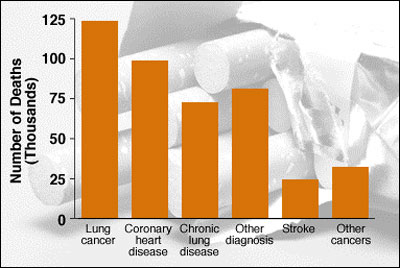
The medical consequences of nicotine exposure result from effects of both the nicotine itself and how it is taken. The most deleterious effects of nicotine addiction are the result of tobacco use, which accounts for one-third of all cancers. Foremost among the cancers caused by tobacco is lung cancer-the number one cancer killer of both men and women. Cigarette smoking has been linked to about 90 percent of all lung cancer cases.
In addition to lung cancer, smoking also causes lung diseases such as chronic bronchitis and emphysema, and it has been found to exacerbate asthma symptoms in adults and children. Smoking is also associated with cancers of the mouth, pharynx, larynx, esophagus, stomach, pancreas, cervix, kidney, ureter, and bladder. The overall rates of death from cancer are twice as high among smokers as among nonsmokers, with heavy smokers having rates that are four times greater than those of nonsmokers. Cigarette smoking is the most important preventable cause of cancer in the United States.
| 430,000 annual deaths are attributable to cigarette smoking |
 |
| Source: CDC, MMWR 1997; 46; 448-51 |
In addition to its ability to cause cancer, a relationship between cigarette smoking and coronary heart disease was first reported in the 1940s. Since that time, it has been well documented that smoking substantially increases the risk of heart disease, including stroke, heart attack, vascular disease, and aneurysm. It is estimated that nearly one-fifth of deaths from heart disease are attributable to smoking. While we often think of medical consequences that result from direct use of tobacco products, passive or secondary smoke also increases the risk for many diseases. Environmental tobacco smoke (ETS) is a major source of indoor air contaminants; secondhand smoke is estimated to cause approximately 3,000 lung cancer deaths per year among nonsmokers and contributes to as many as 40,000 deaths related to cardiovascular disease. Exposure to tobacco smoke in the home increases the severity of asthma for children and is a risk factor for new cases of childhood asthma. ETS exposure has been linked also with sudden infant death syndrome. Additionally, dropped cigarettes are the leading cause of residential fire fatalities, leading to more than 1,000 such deaths each year.
At higher doses, such as the nicotine that can be found in some insecticide sprays, nicotine can be extremely toxic, causing vomiting, tremors, convulsions, and death. Nicotine poisoning has been reported from accidental ingestion of insecticides by adults and ingestion of tobacco products by children and pets. Death usually results in a few minutes from respiratory failure caused by paralysis.
Laboratory research indicates that cigarette smoking causes toxic cardiovascular effects. For this reason, nicotine replacement medicines such as nicotine gum and the patch have been extensively evaluated for cardiovascular toxicity, especially for patients with cardiac disease. These trials suggest that use of nicotine replacements for smoking cessation does not increase cardiovascular risk. These findings are consistent with the generally slower absorption and lower doses of nicotine obtained from the medicines as compared to tobacco products, and to the absence of carbon monoxide and numerous other toxins in tobacco smoke.
In pregnant women, carbon monoxide (a lethal gas) and the high doses of nicotine obtained when they inhale tobacco smoke interferes with oxygen supply to the fetus. Nicotine readily crosses the placenta, and nicotine concentrations in the fetus can be as much as 15 percent higher than maternal levels. It appears that nicotine is concentrated in fetal blood, amniotic fluid, and breast milk. Another ingredient of tobacco smoke, carbon monoxide, has been shown to inhibit the release of oxygen into fetal tissues. These factors, combined, may account for the developmental delays seen in some fetuses and infants of smoking mothers.
Women who smoke during pregnancy are at greater risk than nonsmokers for premature delivery, and there is a risk of lower birth weight for infants carried to term. In the United States it is estimated that 20 percent or more of pregnant women smoke throughout their pregnancies. The adverse effects of smoking may occur in every trimester of pregnancy; they range from spontaneous abortions in the first trimester to increased premature delivery rates and decreased birth weights in the final trimester. The decreased birth weights seen in infants of mothers who smoke reflects a dose-dependent relationship: the more the woman smokes during pregnancy, the greater the reduction of infant birth weight. Conversely, women who give up smoking early in pregnancy have infants of similar weight to those of nonsmokers.
Yes, extensive research has shown that behavioral and pharmacological treatments such as the nicotine patch and gum, and buproprion (Zyban) for nicotine addiction do work. For those individuals motivated to quit smoking, a combination of behavioral and pharmacological treatments can increase the success rate approximately twofold over placebo treatments. Furthermore, smoking cessation can have an immediate positive impact on an individual's health; for example, a 35-year-old man who quits smoking will, on the average, increase his life expectancy by 5.1 years.
[Back to top]